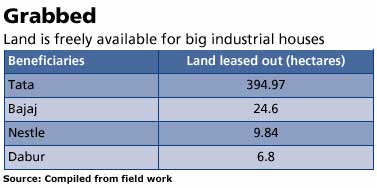Take off
Take off
The state's industrialisation drive has been detrimental for agricultural growth on the whole. But it has not always harmed farmers. In some cases, land has been acquired below the market price, in others, market-driven transactions have been embraced by farmers, presumably because they have benefited, if only in the short term.
But the forced, cheap acquisitions stand out. "The actual cost of agricultural land in the terai is Rs 25 lakh per hectare at the minimum and goes up to Rs 125 lakh,' says a farmer at Bajpur in Udham Singh Nagar. The price shoots up near Kundeshwari and at Rudrapur, both industrial hubs, to Rs 250 lakh per ha. But real estate speculators and land sharks don't pay anywhere near the higher end of market rates. Under provisions of the new policy, land prices in these areas have been pegged at Rs 70 lakh per ha. The Pant Nagar University authorities, for instance, have given prime land to the Tatas for much less."Surprisingly, this land was given on lease to the Tatas for 90 years, at Rs 12.5 lakh per ha,' says a sidcul employee, on condition of anonymity. Some 350 factories in the Rudrapur-Pantnagar industrial estate have also been leased out land at remarkably low prices. The Tatas have got 394.97 ha in this belt. Bajaj, Nestle and Dabur were given leases at rates varying between Rs 56 lakh and Rs 70 lakh per ha (see table: Grabbed). "Terai lands are some of the most fertile not only in the state but in the country. And in less than three years, nearly 2,225 ha of land have been occupied in the terai by industrial giants,' says Rajiv Lochan Shah, a social activist based in Uttaranchal. About 1,350 ha of productive farm land in Pant Nagar, 475 ha in Sitarganj and 345 ha in Kashipur have been acquired in this way,' says Rupesh Kumar Singh of The Sunday Post, a weekly published from Haldwani. sidcul has converted a total of around 2,170 ha of productive agricultural land into industrial estates.
"Terai lands are some of the most fertile not only in the state but in the country. And in less than three years, nearly 2,225 ha of land have been occupied in the terai by industrial giants,' says Rajiv Lochan Shah, a social activist based in Uttaranchal. About 1,350 ha of productive farm land in Pant Nagar, 475 ha in Sitarganj and 345 ha in Kashipur have been acquired in this way,' says Rupesh Kumar Singh of The Sunday Post, a weekly published from Haldwani. sidcul has converted a total of around 2,170 ha of productive agricultural land into industrial estates.
In Kashipur, the land that was being acquired was actually under cultivation. In Bajpur, too, sidcul was trying to acquire land under the plough, provoking fierce resistance, especially because promises of employment were not kept. "These lands are even better than those of Punjab and Haryana. Instead of using these lands for agriculture, the government is selling them off to industrial estates,' says Rajiv Lochan Shah. "The state does not seem to learn from its neighbours. Uttar Pradesh, of which it was a part, has never allotted good agricultural land to industrial estates so mindlessly,' says Rawat.
Losing livelihoods  If official pronouncements are to be taken seriously, the loss of land will be compensated by the generation of employment opportunities. The state industrial policy lays a high rhetorical priority on improving standards of living and providing employment to all under a 10-year scheme. The problem is that local people are not getting jobs in the new factories. "According to an employment office at Rudrapur, in the last two years only 136 local people have been employed in the new industries (see table: Job crunch),' says Rajiv Lochan Shah.
If official pronouncements are to be taken seriously, the loss of land will be compensated by the generation of employment opportunities. The state industrial policy lays a high rhetorical priority on improving standards of living and providing employment to all under a 10-year scheme. The problem is that local people are not getting jobs in the new factories. "According to an employment office at Rudrapur, in the last two years only 136 local people have been employed in the new industries (see table: Job crunch),' says Rajiv Lochan Shah.
In many cases, land is obtained with false assurances of employment. Villagers of Kashipur were conned in this way when the India Glycols factory bought land from them. Today, the factory employs 579 people. Of the 244 executives and 64 trainees and apprentices none are from the area. Of the junior staff (271) only 30 per cent are local people. "Fissiparous tendencies cannot be ruled out in the near future if such a system persists,' warns Rawat.
More than land
In the headlong rush towards industrialisation, environmental concerns are also being brushed under the carpet. "Nearly 24,000 trees have been felled for the extension of an industrial area to entrepreneurs in Sitarganj,' says Keval Krishna Dhal, a social activist based at Sitarganj. "The forests of Barakoli range near Sitarganj and Kalapani khatta near Chorgallia in Nainital district have now been earmarked as the next target to be felled by industrial encroachers.' The impact of industrial growth has clearly not been factored in. "Effect of pollution generated by these industries on environment and on the agricultural fields/crops in areas surrounding the estates has not been considered,' says Rajiv Lochan Shah. "When the state government has got no control over polluting units at present, how will pollution from so many big industries be tackled?' he asks. There have been reports of several paper, sugar and distillery units polluting air, water, and land in the terai (see







